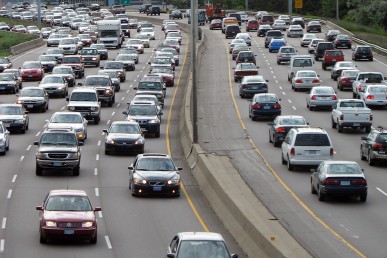‘AI’ could help drivers avoid snarls
 Aggravation is not the only measure of the cost of traffic jams.
Aggravation is not the only measure of the cost of traffic jams.
In Chicago, delays due to congestion cost $6.2 billion a year in wasted fuel, time, and increased pollution, making it the number-one city in the country in yearly costs to commuters, according to the Texas Transportation Institute.
“Even a 1 percent improvement in traffic flow can translate into millions of dollars in savings,” says John Dillenburg, associate director of the University of Illinois at Chicago Artificial Intelligence Laboratory. With good information, everyone—commuters, interstate travelers, trucks and city buses—can get around a little easier, he said.
UIC’s AI Lab has received a $2.9 million research contract from the Illinois Department of Transportation to continue their research, development and operation of the real-time traffic information service, the Gateway Traveler Information System, and its website, TravelMidwest.com.
Real-time traffic maps on the Travel Midwest site already span an extensive area around Chicago, including northwest Indiana and Wisconsin. The new funding to UIC, together with a $368,000 grant-partnership with the University of Wisconsin, will expand coverage to the entire I-94 corridor from Minneapolis to Detroit, and the rest of Illinois.
The maps can be scrolled and zoomed to allow for the best view. Information is displayed in layers—travel times, congestion, construction, incidents, road labels and shields, dynamic message signs, cameras, and special events. The map allows users to focus on the most useful information and to remove unneeded data.
UIC’s partnership with IDOT dates back to a project begun in 1991, said Dillenburg, who is co-principal investigator on the new grant with Peter Nelson, director of the AI Lab and dean of the UIC College of Engineering.
“The first traffic displays were ‘war maps’ set up in traffic management centers,” Dillenburg said. “The AI Lab had one of the first real-time traffic maps online.”
In addition to maintaining the real-time maps, the Gateway Traveler Information System interfaces with all the public transportation systems in its coverage area. The system analyzes reported incidents and decides who needs to be informed.
“A back-up on an Illinois highway may create problems upstream for Wisconsin,” Dillenburg said. “The system filters incoming information, and those likely to be affected are informed. But everyone isn’t overloaded with data coming from everywhere at once.”
The Gateway system gathers data from a variety of sources, including IDOT, the Illinois Tollway Authority, the Chicago Skyway, the Wisconsin DOT, the Indiana DOT, the Indiana Toll Road, and the Michigan DOT, among others.
The contract supports 15 full-time staff and more than 15 part-time staff and students.
“What was once a nine to five operation is now a 24/7 command center,” Dillenburg said.
Future plans include an enhanced mobile app.
